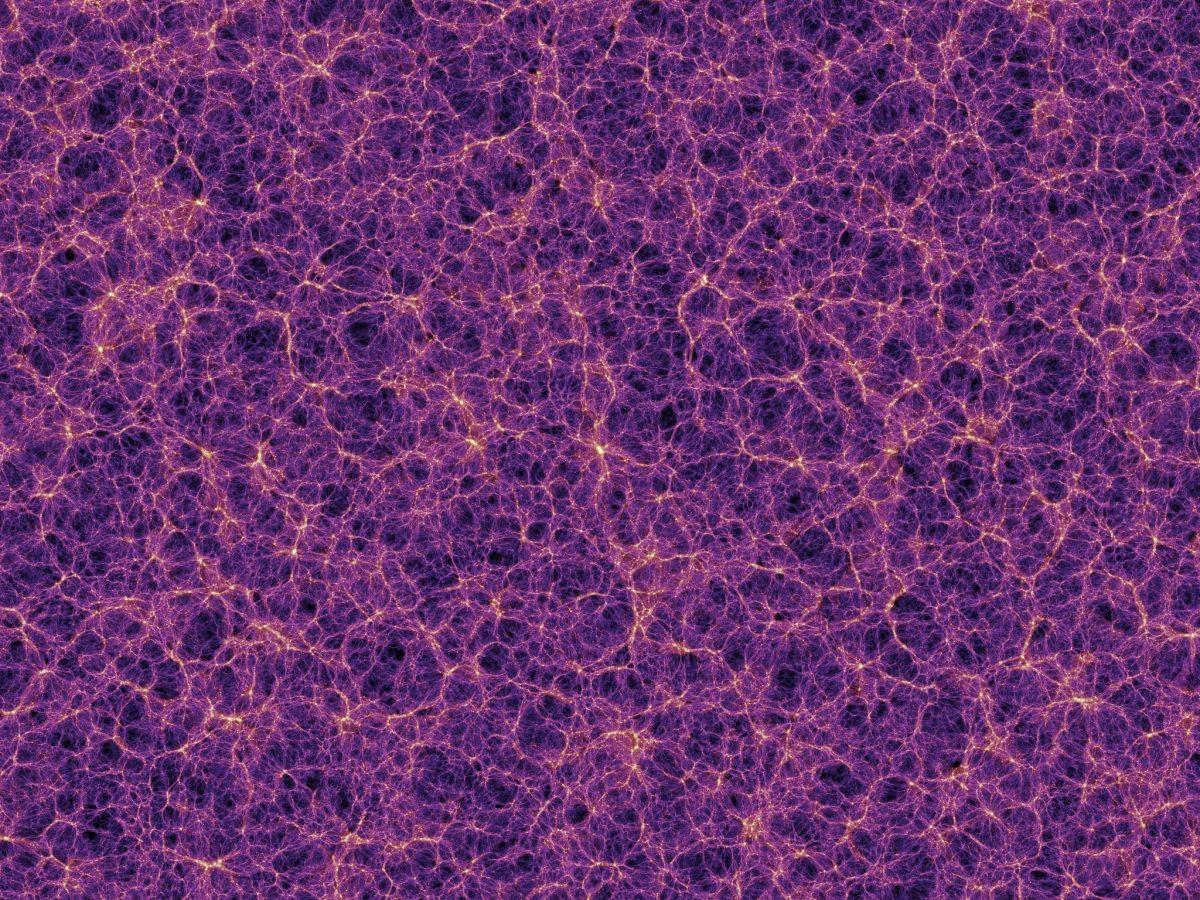 A simulation of the large-scale structure of the universe demonstrates complex non-recurring clusters. But from our point of view, we can see the final volume of the Universe. What lies beyond?
A simulation of the large-scale structure of the universe demonstrates complex non-recurring clusters. But from our point of view, we can see the final volume of the Universe. What lies beyond?13.8 billion years ago, the known universe began with the Big Bang. During this time, space has expanded, matter has experienced gravitational attraction, and as a result we have received such a Universe, which we are observing today. But even if it is huge, our observations have limits. At a certain distance, the galaxies disappear, the stars grow dim, and we receive no signals from remote parts of the Universe. And what is beyond this limit? This week the reader asks:
If the universe is finite in volume, where is its boundary? Is it possible to approach her? What will it look like?
Let's start with our current location, and take a look as far as we can.
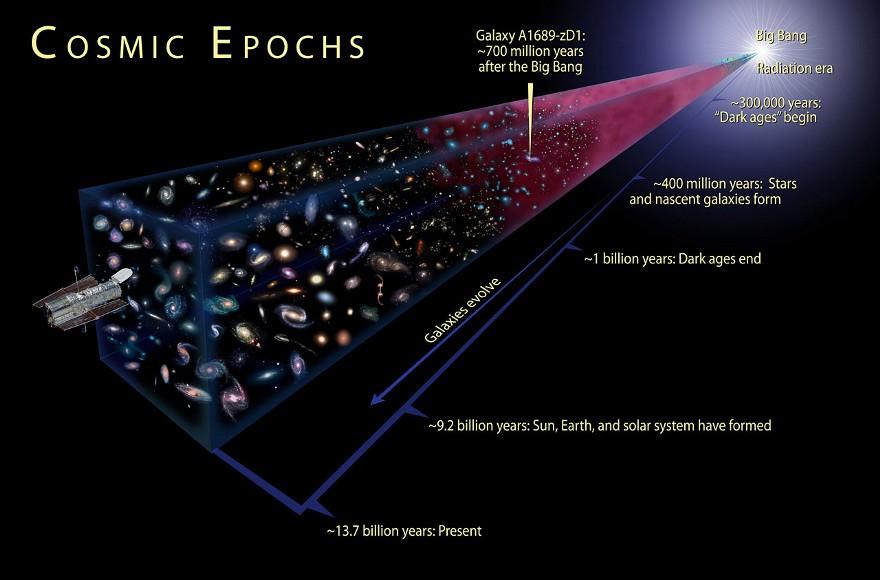 The stars and galaxies we see nearby look the same as ours. But the further we look, the deeper into the past of the Universe we look: there it is less structured, younger, and not so strongly developed.
The stars and galaxies we see nearby look the same as ours. But the further we look, the deeper into the past of the Universe we look: there it is less structured, younger, and not so strongly developed.In the immediate vicinity of us, the universe is full of stars. If you fly over 100,000 light years, you can leave the Milky Way behind you. Behind it stretches the sea of galaxies - perhaps two trillion inside the observable universe. There is a huge number of varieties, shapes, sizes and masses. But looking at more distant galaxies, you can see something unusual: the farther the galaxy, the more likely it is that it will be smaller in size and in mass, and its stars will be stronger than the blue color of the nearby galaxies.
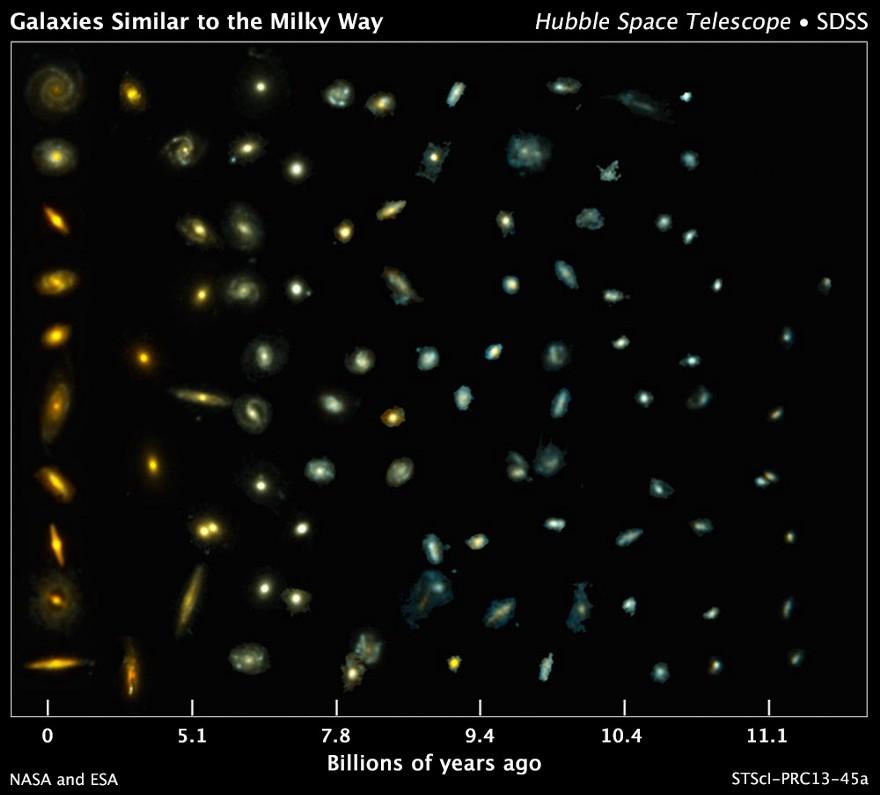 What is the difference between galaxies at different times in the history of the universe?
What is the difference between galaxies at different times in the history of the universe?This makes sense if the universe has a beginning: a birthday. This was the Big Bang, the day when the known universe was born. The age of the galaxy, located relatively close to ours, coincides with our age. But looking at a galaxy that is billions of light years away, we see a light that had to go billions of years before it reached our eyes. The age of the galaxy, the light of which took 13 billion years to reach us, should be less than a billion years, and looking farther and farther into the space we, in fact, look into the past.
 The composite of ultraviolet, visible and infrared light produced by the Hubble project of the eXtreme Deep Field is the greatest image of the distant Universe produced
The composite of ultraviolet, visible and infrared light produced by the Hubble project of the eXtreme Deep Field is the greatest image of the distant Universe producedAbove is a picture of the Hubble
eXtreme Deep Field project (XDF), the deepest image of the remote Universe. It has thousands of galaxies that are located at very different distances from us and from each other. But in simple color it is impossible to see that a certain spectrum is associated with each galaxy, in which clouds of gas absorb light of perfectly defined wavelengths, thanks to simple atomic physics. With the expansion of the universe, this length is stretched, so more distant galaxies seem to us more red. This physics allows us to make assumptions about the distance to them, and when we arrange these distances, it turns out that the youngest and smallest are the most distant galaxies.
Behind the galaxies should be the first stars, and then nothing but neutral gas — when the universe did not have time to pull matter into structures sufficiently dense for the formation of stars. Having passed a few million years ago, we will see that the radiation in the Universe was so hot that neutral atoms could not form there, which means that the photons constantly bounced off the charged particles. When neutral atoms were formed, this light should just go in a straight line and go on forever, since it is not affected by anything but the expansion of the Universe. The discovery of this residual luminescence - the background radiation - more than 50 years ago was the final confirmation of the Big Bang.
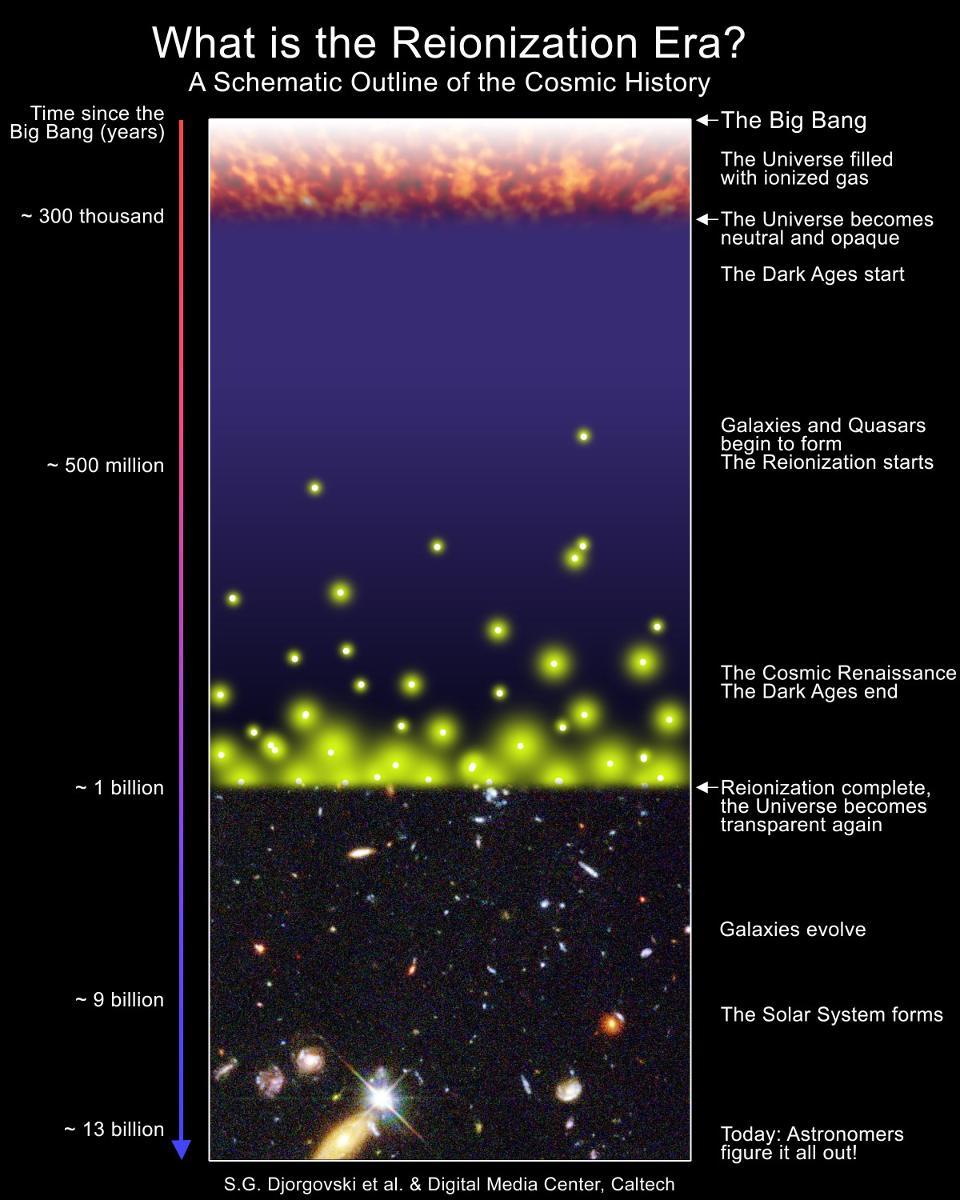 A systematic diagram of the history of the universe, describing the reionization . Before the formation of stars and galaxies, the universe was filled with neutral atoms that blocked the light. And although most of the Universe underwent reionization only after 550 million years, some of the more fortunate parts were practically reionized ahead of this period.
A systematic diagram of the history of the universe, describing the reionization . Before the formation of stars and galaxies, the universe was filled with neutral atoms that blocked the light. And although most of the Universe underwent reionization only after 550 million years, some of the more fortunate parts were practically reionized ahead of this period.From our current location, we can look in any direction and see the same course of space history. Today, 13.8 billion years after the Big Bang, we have galaxies and stars known to us. Before, galaxies were smaller, bluer, younger and less developed. Before that there were the first stars, and before that - only neutral atoms. Up to neutral atoms there was ionized plasma, and before it there were free protons and neutrons, spontaneous appearance of matter and antimatter, free quarks and gluons, all unstable particles of the Standard Model, and, finally, the Big Bang moment itself. Looking at more and more distant distances is the same as looking into the past.
 Representation of the artist in the form of a logarithmic concept of the observable universe. The galaxies are followed by a large-scale structure and a hot, dense plasma of the Big Bang on the outskirts. The edge is the boundary only in time.
Representation of the artist in the form of a logarithmic concept of the observable universe. The galaxies are followed by a large-scale structure and a hot, dense plasma of the Big Bang on the outskirts. The edge is the boundary only in time.Although this defines our observable Universe — with the theoretical bang of the Big Bang, located at
46.1 billion light years from our location , it will not be some real boundary of space. It is just a boundary in time; there are limitations to what we can see, since the speed of light allowed information to travel only 13.8 billion years after the hot Big Bang. This distance is more than 13.8 billion light years, since the fabric of the Universe has expanded (and continues to expand), but it is of course still. But what about the time before the Big Bang? What would you see if you somehow fell within one fraction of a second before the Universe possessed the highest of energies, was dense, hot, full of matter, antimatter and radiation?
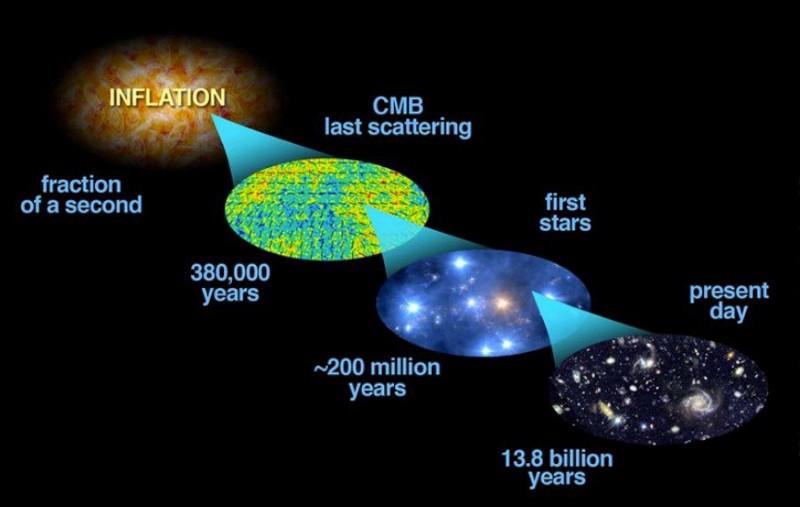 Inflation provided a hot big bang and gave rise to the observable universe, to which we have access. Inflation fluctuations sowed seeds that grew into the structure it has today
Inflation provided a hot big bang and gave rise to the observable universe, to which we have access. Inflation fluctuations sowed seeds that grew into the structure it has todayYou would discover a state of cosmic inflation, in which the universe expanded extremely rapidly, and in which the energy inherent in the space itself dominated. The space at this time expanded exponentially, was stretched to a flat state, acquired the same properties in all places, then existing particles were scattered in different directions, and fluctuations inherent in quantum fields were stretched across the universe. When inflation ended in the place where we are, the hot Big Bang filled the Universe with matter and radiation, and gave birth to that part of the Universe - the observable Universe - which we see today. And now, 13.8 billion years later, we have what we have.
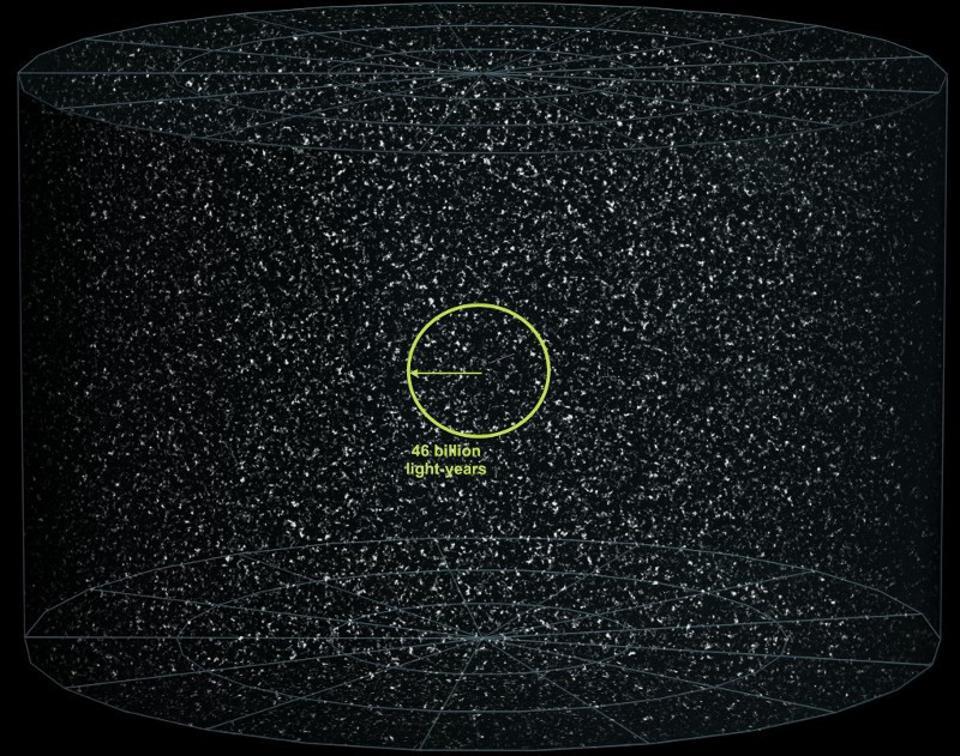 The observable Universe can stretch over 46 billion light-years in all directions from our point of view, but there are certainly more unobserved parts of the Universe, perhaps even an infinite number, similar to the one in which we are
The observable Universe can stretch over 46 billion light-years in all directions from our point of view, but there are certainly more unobserved parts of the Universe, perhaps even an infinite number, similar to the one in which we areOur location is nothing special, neither in space nor in time. What we can see at 46 billion light years does not attach any special significance to this border or this location. This is just a limitation of our field of view. If we could somehow make a photograph of the entire Universe, stretching beyond the observed boundary, such as it became 13.8 billion years after the Big Bang, it would all look like our nearest part. It would have a great cosmic network of galaxies, clusters,
galactic filaments , cosmic
voids extending beyond a relatively small area visible to us. Any observer anywhere would see the Universe, very similar to the one we see from our point of view.
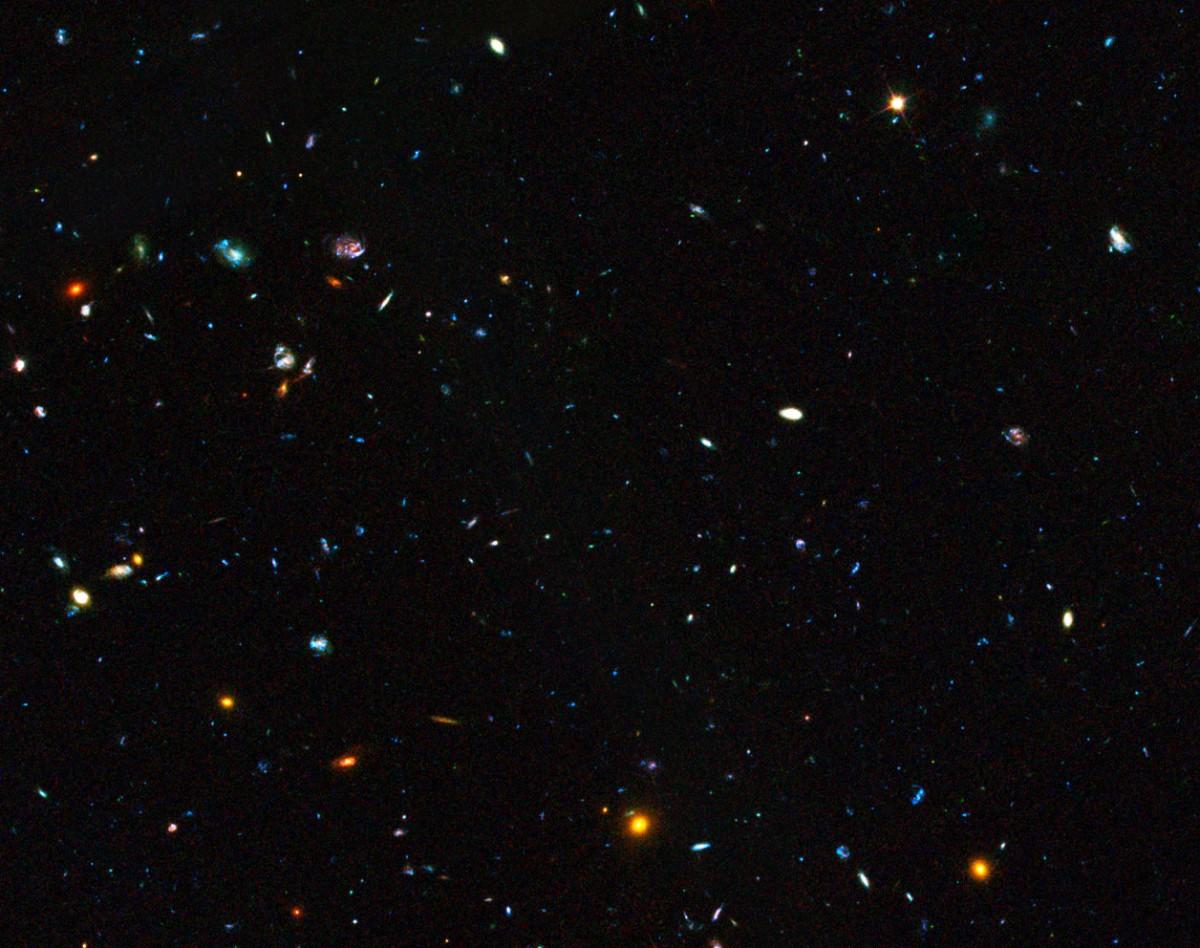 One of the most distant observations of the Universe demonstrates stars and galaxies located nearby, but galaxies from external areas just look younger and less developed. From their point of view, they are 13.8 billion years old, and they are more developed, and we see them as they were billions of years ago.
One of the most distant observations of the Universe demonstrates stars and galaxies located nearby, but galaxies from external areas just look younger and less developed. From their point of view, they are 13.8 billion years old, and they are more developed, and we see them as they were billions of years ago.The individual parts would be different, as are the details of our solar system, galaxy, local group, etc. from the details of another observer. But the Universe is not limited in volume - only the part we observe is limited. The reason for this is the temporary border - the Big Bang - separating us from the rest. We can approach it only with the help of telescopes, peeping in the early days of the universe, and in theory. Until we figure out how to trick the current time in one direction, this will be our only approach to understanding the "boundary" of the Universe. But in space, there are no boundaries. As far as we know, someone on the edge of our observable universe would just see us on the edge of his observable universe!
Ethan Siegel - astrophysicist, popularizer of science, blog Starts With A Bang! He wrote the books Beyond The Galaxy , and Treknologiya: Star Trek Science [ Treknology ].FAQ: if the universe is expanding, why aren't we expanding ; why the age of the universe does not coincide with the radius of the observed part of it .